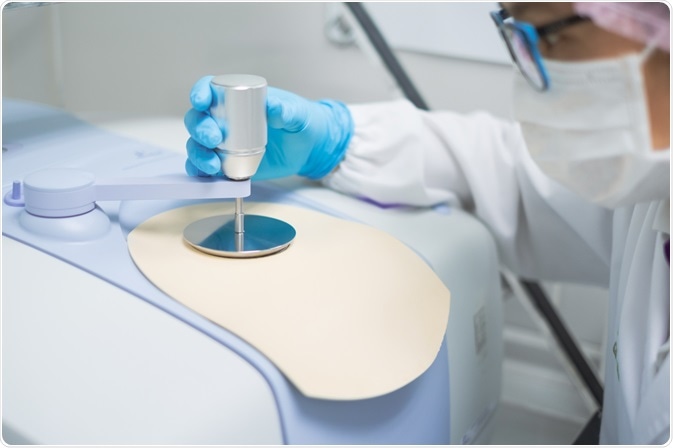Standard reference materials (SRMs) are relied on by academic, industrial, and government sectors to further research and development, facilitate commerce, and support trade.

Image Credit: SUKJAI PHOTO/Shutterstock.com
SRMs are used in a range of fields including environmental analysis, health measurements, industrial materials production and analysis, and general measurements within the realms of science and metrology.
The differences between standard reference materials and reference materials
The National Institute of Standards and Technology (NIST) has created a compilation of more than 1,300 SRMs to assist with accurate and compatible measuring across various industries. in the US, this list of SRMs is often used as a go-to reference to perform calibration measurements for instruments, assist with quality assurance, verify the composition of a substance, and advance the research and development of novel measurement techniques.
SRMs are sometimes confused with reference materials (RMs), substances that are suitably homogeneous and stable in relation to certain properties that are relevant for its measurement or analytical use. SRMs are also occasionally confused with certified reference materials (CRMs), which are reference materials that have accompanying documentation to certify a particular property of the material. Such documentations are provided by official governing bodies.
SRMs are unique to RMs and CRMs because they are RMs that also meet certification criteria outlined by NIST. Certificates are issued by NIST to report the characteristics of SRMs, providing scientists are researchers with the necessary information to use the material correctly.
NIST outlines that SRMs are developed and used for three main purposes. The first is to assist in the development of accurate analytical methods. Instrument calibration and substance analysis is the second purpose, which is often used for trade and to facilitate quality control. The final purpose is that of ensuring the adequacy and integrity of quality control systems in the long term.
NIST SRMs are produced commercially, with traceability to NIST standards for chemical measurements. Certificates produced for NIST SRMs are in accordance with ISO Guide 31: 2000 and define the name and purpose of the material, along with the instructions for use and storage, certified property value with associated uncertainty, the method used to obtain property values.
What notable reference materials have been developed?
Research papers that describe SRMs are often referring to new and unique materials. While the method to characterize these materials may not be novel, the materials that they are being used to describe frequently are. Over the years, NIST has produced a vast number of synthetic greenhouse gas mixture SRMs, including those for CO2, CH4, and N2O.
Additionally, SRMs have recently been developed for whole natural air, with values developed for greenhouse gases. These SRMS will no doubt play a vital role in the future as identifying and monitoring greenhouse gases levels becomes increasingly important in the fight against global warming.
Another recently developed SRM has even been developed for cigarette tobacco filler with assigned values for nicotine and two tobacco-specific nitrosamines.
Finally, researchers have recently established the very first serum-based SRM with assigned values for the vitamin D metabolites of 25-hydroxyvitamin D2 [25(OH)D2], 25-hydroxyvitamin D3 [25(OH)D3], and 3-epi-25-hydroxyvitamin D3 [3-epi-25(OH)D3]. Vitamin D is one of the most vital nutrients for sustaining human health. It belongs to the steroid hormone family and is responsible for regulating calcium metabolism and also influences cell proliferation and differentiation.
Further to this, a wide body of research has linked vitamin D deficiency with numerous chronic illnesses, such as bone metabolic disorders, cardiovascular diseases, diabetes, and tumors. Due to the important role of vitamin D, a serum-based SRM with assigned values for the vitamin D metabolites will likely be highly valuable in future medical research.
Future directions
Currently, scientists are working on establishing SRMs to support the measurements of organic pollutants and trace elements in fine particulate matter (PM). SRM 1648 Urban Particulate Matter and SRM 1649 Urban Dust, issued in 1978 and 1982, respectively, are two of the most widely-used environmental-matrix SRMs.
However, there is an urgent need for new SRMs to support the measurement of PM with smaller molecular sizes, as the importance of monitoring air pollution around the world becomes more greatly emphasized. In the coming years, we can expect the development of more SRMs that are relevant to PM.
Because of the small size of PM molecules, it is challenging to obtain a sufficient quantity of the substance to produce an SRM. Recently, scientists have experimented with different methods to collect ambient PM, and some successes have been achieved. More advances will likely be made in the near future.
Sources:
- SRM Definitions. NIST. Available at: https://www.nist.gov/srm/srm-definitions
- About NIST SRMs. NIST. Available at: https://www.nist.gov/srm/about-nist-srms
- Phinney, K., Bedner, M., Tai, S., Vamathevan, V., Sander, L., Sharpless, K., Wise, S., Yen, J., Schleicher, R., Chaudhary-Webb, M., Pfeiffer, C., Betz, J., Coates, P. and Picciano, M., 2011. Development and Certification of a Standard Reference Material for Vitamin D Metabolites in Human Serum. Analytical Chemistry, 84(2), pp.956-962. https://pubs.acs.org/doi/10.1021/ac202047n
- Sander, L., Pritchett, J., Daniels, Y., Wood, L., Lang, B., Wise, S., Yen, J., Johnson, T., Walters, M., Phillips, T., Holman, M., Lee, G., Lisko, J., Lane, B., Valentin-Blasini, L. and Watson, C., 2017. Development of a Cigarette Tobacco Filler Standard Reference Material. Analytical Chemistry, 89(19), pp.10461-10467. https://pubs.acs.org/doi/10.1021/acs.analchem.7b02550
- Wise, S., 2018. What is novel about certified reference materials?. Analytical and Bioanalytical Chemistry, 410(8), pp.2045-2049. https://link.springer.com/article/10.1007/s00216-018-0916-y#citeas
Further Reading
Last Updated: Oct 20, 2021